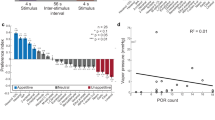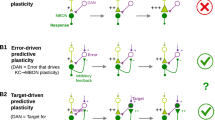Abstract
Sensory systems create neural representations of environmental stimuli and these representations can be associated with other stimuli through learning. Are spike patterns the neural representations that get directly associated with reinforcement during conditioning? In the moth Manduca sexta, we found that odor presentations that support associative conditioning elicited only one or two spikes on the odor's onset (and sometimes offset) in each of a small fraction of Kenyon cells. Using associative conditioning procedures that effectively induced learning and varying the timing of reinforcement relative to spiking in Kenyon cells, we found that odor-elicited spiking in these cells ended well before the reinforcement was delivered. Furthermore, increasing the temporal overlap between spiking in Kenyon cells and reinforcement presentation actually reduced the efficacy of learning. Thus, spikes in Kenyon cells do not constitute the odor representation that coincides with reinforcement, and Hebbian spike timing–dependent plasticity in Kenyon cells alone cannot underlie this learning.
This is a preview of subscription content, access via your institution
Access options
Subscribe to this journal
Receive 12 print issues and online access
$209.00 per year
only $17.42 per issue
Buy this article
- Purchase on Springer Link
- Instant access to full article PDF
Prices may be subject to local taxes which are calculated during checkout




Similar content being viewed by others
References
Hallem, E.A. & Carlson, J.R. Coding of odors by a receptor repertoire. Cell 125, 143–160 (2006).
Stopfer, M., Jayaraman, V. & Laurent, G. Intensity versus identity coding in an olfactory system. Neuron 39, 991–1004 (2003).
Daly, K.C., Wright, G.A. & Smith, B.H. Molecular features of odorants systematically influence slow temporal responses across clusters of coordinated antennal lobe units in the moth Manduca sexta. J. Neurophysiol. 92, 236–254 (2004).
Brown, S.L., Joseph, J. & Stopfer, M. Encoding a temporally structured stimulus with a temporally structured neural representation. Nat. Neurosci. 8, 1568–1576 (2005).
Mazor, O. & Laurent, G. Transient dynamics versus fixed points in odor representations by locust antennal lobe projection neurons. Neuron 48, 661–673 (2005).
Perez-Orive, J. et al. Oscillations and sparsening of odor representations in the mushroom body. Science 297, 359–365 (2002).
Hammer, M. An identified neuron mediates the unconditioned stimulus in associative olfactory learning in honeybees. Nature 366, 59–63 (1993).
Schröter, U. & Menzel, R. A new ascending sensory tract to the calyces of the honeybee mushroom body, the subesophageal-calycal tract. J. Comp. Neurol. 465, 168–178 (2003).
Dacks, A.M., Christensen, T.A., Agricola, H., Wollweber, L. & Hildebrand, J.G. Octopamine-immunoreactive neurons in the brain and subesophageal ganglion of the hawkmoth Manduca sexta. J. Comp. Neurol. 488, 255–268 (2005).
Heisenberg, M., Borst, A., Wagner, S. & Byers, D. Drosophila mushroom body mutants are deficient in olfactory learning. J. Neurogenet. 2, 1–30 (1985).
de Belle, J.S. & Heisenberg, M. Associative odor learning in Drosophila abolished by chemical ablation of mushroom bodies. Science 263, 692–695 (1994).
Erber, J. Retrograde amnesia in honeybees (Apis mellifera carnica). J. Comp. Physiol. Psychol. 90, 41–46 (1976).
Heisenberg, M. Mushroom body memoir: from maps to models. Nat. Rev. Neurosci. 4, 266–275 (2003).
Davis, R.L. Olfactory memory formation in Drosophila: from molecular to systems neuroscience. Annu. Rev. Neurosci. 28, 275–302 (2005).
Krashes, M.J., Keene, A.C., Leung, B., Armstrong, J.D. & Waddell, S. Sequential use of mushroom body neuron subsets during Drosophila odor memory processing. Neuron 53, 103–115 (2007).
Keene, A.C. & Waddell, S. Drosophila olfactory memory: single genes to complex neural circuits. Nat. Rev. Neurosci. 8, 341–354 (2007).
Christensen, T.A. & Hildebrand, J.G. Male-specific, sex pheromone–selective projection neurons in the antennal lobes of the moth Manduca sexta. J. Comp. Physiol. [A] 160, 553–569 (1987).
Daly, K.C. & Smith, B.H. Associative olfactory learning in the moth Manduca sexta. J. Exp. Biol. 203, 2025–2038 (2000).
Bitterman, M.E., Menzel, R., Fietz, A. & Schäfer, S. Classical conditioning of proboscis extension in honeybees (Apis mellifera). J. Comp. Psychol. 97, 107–119 (1983).
Fan, R.J., Anderson, P. & Hansson, B. Behavioural analysis of olfactory conditioning in the moth spodoptera littoralis (Boisd.) (Lepidoptera: noctuidae). J. Exp. Biol. 200, 2969–2976 (1997).
Müller, U. Prolonged activation of cAMP-dependent protein kinase during conditioning induces long-term memory in honeybees. Neuron 27, 159–168 (2000).
Skiri, H.T., Stranden, M., Sandoz, J.C., Menzel, R. & Mustaparta, H. Associative learning of plant odorants activating the same or different receptor neurones in the moth Heliothis virescens. J. Exp. Biol. 208, 787–796 (2005).
Cassenaer, S. & Laurent, G. Hebbian STDP in mushroom bodies facilitates the synchronous flow of olfactory information in locusts. Nature 448, 709–713 (2007).
Carlsson, M.A., Knüsel, P., Verschure, P.F.M.J. & Hansson, B.S. Spatio-temporal Ca2+ dynamics of moth olfactory projection neurones. Eur. J. Neurosci. 22, 647–657 (2005).
Wilson, R.I., Turner, G.C. & Laurent, G. Transformation of olfactory representations in the Drosophila antennal lobe. Science 303, 366–370 (2004).
Wilson, R.I. & Laurent, G. Role of GABAergic inhibition in shaping odor-evoked spatiotemporal patterns in the Drosophila antennal lobe. J. Neurosci. 25, 9069–9079 (2005).
Vinje, W.E. & Gallant, J.L. Sparse coding and decorrelation in primary visual cortex during natural vision. Science 287, 1273–1276 (2000).
Hammer, M. & Menzel, R. Multiple sites of associative odor learning as revealed by local brain microinjections of octopamine in honeybees. Learn. Mem. 5, 146–156 (1998).
Szyszka, P., Ditzen, M., Galkin, A., Galizia, C.G. & Menzel, R. Sparsening and temporal sharpening of olfactory representations in the honeybee mushroom bodies. J. Neurophysiol. 94, 3303–3313 (2005).
Wang, Y. et al. Stereotyped odor-evoked activity in the mushroom body of Drosophila revealed by green fluorescent protein–based Ca2+ imaging. J. Neurosci. 24, 6507–6514 (2004).
Turner, G.C., Bazhenov, M. & Laurent, G. Olfactory representations by Drosophila mushroom body neurons. J Neurophysiol. 99, 734–746 (2007).
Thum, A.S., Jenett, A., Ito, K., Heisenberg, M. & Tanimoto, H. Multiple memory traces for olfactory reward learning in Drosophila. J. Neurosci. 27, 11132–11138 (2007).
Quiroga, R.Q., Reddy, L., Kreiman, G., Koch, C. & Fried, I. Invariant visual representation by single neurons in the human brain. Nature 435, 1102–1107 (2005).
Olshausen, B.A. & Field, D.J. Sparse coding of sensory inputs. Curr. Opin. Neurobiol. 14, 481–487 (2004).
Willshaw, D.J., Buneman, O.P. & Longuet-Higgins, H.C. Non-holographic associative memory. Nature 222, 960–962 (1969).
Marr, D. Simple memory: a theory for archicortex. Phil. Trans. R. Soc. Lond. B 262, 23–81 (1971).
Tanimoto, H., Heisenberg, M. & Gerber, B. Experimental psychology: event timing turns punishment to reward. Nature 430, 983 (2004).
Drew, P.J. & Abbott, L.F. Extending the effects of spike timing–dependent plasticity to behavioral time scales. Proc. Natl. Acad. Sci. USA 103, 8876–8881 (2006).
Izhikevich, E.M. Solving the distal reward problem through linkage of STDP and dopamine signaling. Cereb. Cortex 17, 2443–2452 (2007).
Schwaerzel, M. et al. Dopamine and octopamine differentiate between aversive and appetitive olfactory memories in Drosophila. J. Neurosci. 23, 10495–10502 (2003).
Bell, R.A. & Joachim, F.A. Techniques for rearing laboratory colonies of tobacco hornworms and pink bollworms lepidoptera-sphingidae-gelechiidae. Ann. Entomol. Soc. Am. 69, 365–373 (1976).
Laurent, G. & Naraghi, M. Odorant-induced oscillations in the mushroom bodies of the locust. J. Neurosci. 14, 2993–3004 (1994).
Pouzat, C., Mazor, O. & Laurent, G. Using noise signature to optimize spike-sorting and to assess neuronal classification quality. J. Neurosci. Methods 122, 43–57 (2002).
Acknowledgements
We are grateful to members of the Stopfer laboratory for helpful discussions. We especially thank K. Sun for her excellent animal care. Micrographs were made at the Microscopy and Imaging Core (US National Institute of Child Health and Development, NICHD) with the assistance of V. Schram. We thank C. Wu in the Biometry and Mathematical Statistics Branch, US National Institutes of Health (NIH)/NICHD for his advice on the statistical analysis of the behavioral experiments. This work was supported by grants from the Japan Society for the Promotion of Science (00169, 70510) to I.I., a joint NIH–National Institutes of Standards and Technology postdoctoral fellowship award by the National Research Council to B.R. and an intramural grant from NIH-NICHD to M.S.
Author information
Authors and Affiliations
Corresponding author
Supplementary information
Supplementary Text and Figures
Supplementary Figures 1–6 and Supplementary Methods (PDF 4618 kb)
Rights and permissions
About this article
Cite this article
Ito, I., Ong, Ry., Raman, B. et al. Sparse odor representation and olfactory learning. Nat Neurosci 11, 1177–1184 (2008). https://doi.org/10.1038/nn.2192
Received:
Accepted:
Published:
Issue Date:
DOI: https://doi.org/10.1038/nn.2192
This article is cited by
-
Optimal routing to cerebellum-like structures
Nature Neuroscience (2023)
-
Neural manifolds for odor-driven innate and acquired appetitive preferences
Nature Communications (2023)
-
A behavioural correlate of the synaptic eligibility trace in the nucleus accumbens
Scientific Reports (2022)
-
Characterization of the olfactory system of the giant honey bee, Apis dorsata
Cell and Tissue Research (2020)
-
Dynamic contrast enhancement and flexible odor codes
Nature Communications (2018)



